James Webb Space Telescope: Origins, design and mission objectives
How the James Webb Space Telescope is revolutionizing our view of the cosmos after just one year of operations.
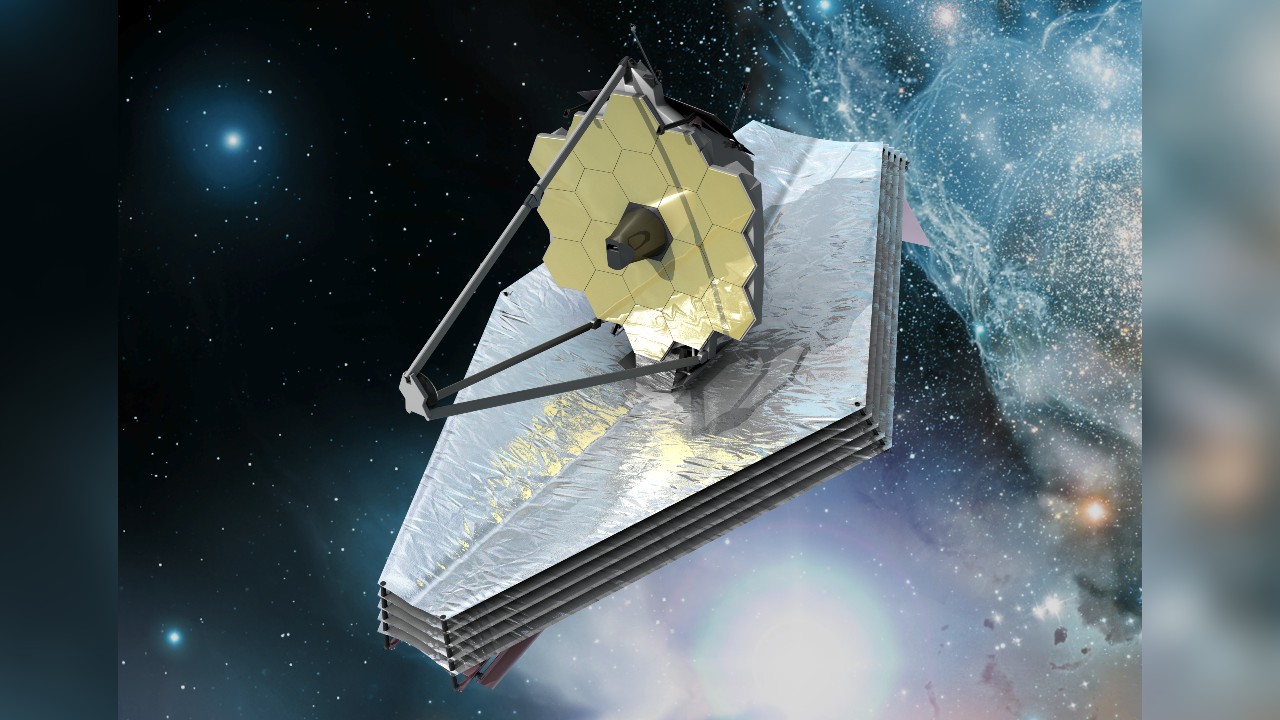
The James Webb Space Telescope (JWST), which launched Dec. 25, 2021 at 7:20 a.m. ET (12:20 p.m. GMT) from the Guiana Space Centre (also known as Europe's Spaceport) in French Guiana, is on a mission to observe some of the faintest, oldest objects in the universe, from a vantage point nearly 1 million miles (1.5 million kilometers) from Earth.
On July 11, President Joe Biden shared the first full-color image captured by JWST, which astronomers hailed as the deepest image of the universe ever taken. The next day, NASA released four more debut images to showcase Webb's incredible capabilities, including close-ups of a distant dying star, an alien exoplanet and a cluster of five galaxies chaotically colliding.
Related: 35 Jaw-dropping James Webb Space Telescope images
Webb has a lot to live up to as the successor of the Hubble Space Telescope, a still-active space observatory capturing spectacular images of the cosmos. In the three decades since Hubble launched in 1990, it has revealed the wonders of the universe in unprecedented detail. It's been used to study cutting-edge topics like dark energy and exoplanets that were scarcely dreamed of when it began operation. Plus, it has captured the public's imagination to the extent that it is now a household name.
The James Webb Space Telescope, known as Webb (like "Hubble"), is operated primarily by NASA, which is providing the bulk of the funding, with the European Space Agency (ESA) and the Canadian Space Agency (CSA) as partners. The telescope is named after one of NASA's early administrators, James E. Webb, who oversaw the creation of the Apollo program in the 1960s, according to NASA.
It was way back in 2002, almost 20 years ago, when Webb's name was first applied to what had previously been referred to as the "Next Generation Space Telescope." That decision was later called into question as JWST's launch neared, with many scientists arguing that Webb participated in discrimination against gay and lesbian NASA employees during his time as an administrator for the agency, and therefore should not have his name affixed to the high-profile observatory, according to Live Science sister site Space.com. (NASA announced in September 2021 that they would not rename the mission, Space.com reported.)
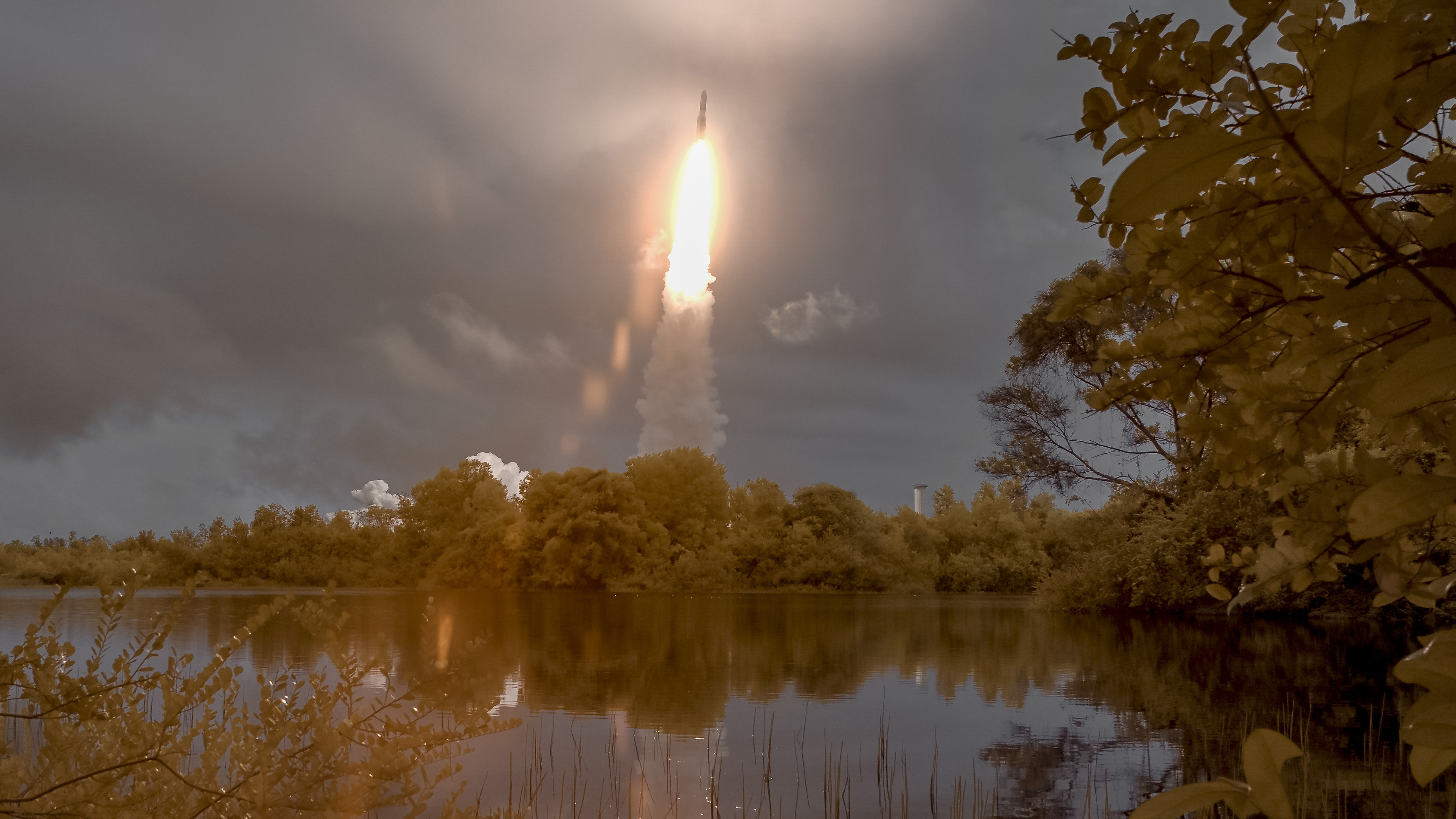
Webb was originally planned to cost half a billion dollars and be ready for launch in 2007, the Atlantic reported. However, these estimates turned out to be over-optimistic, given the enormously complex and innovative design of the spacecraft. Building the telescope cost nearly $10 billion, almost doubling the estimated cost since 2009, according to the U.S. Government Accountability Office.
Nevertheless, the scientists involved in the project believe the results will more than compensate for the time and money invested in it. NASA is keen to emphasize that Webb isn't simply a bigger and more powerful telescope than Hubble. While it is both those things — with more than two and a half times the diameter and a hundred times the sensitivity — at its heart the JWST is a different type of instrument altogether.
Related: How are asteroids and space debris detected before they hit Earth?
Ordinary optical telescopes see in the same part of the spectrum as our own eyes, covering a range of wavelengths between roughly 380 and 740 nanometers (nm), as Live Science has previously reported. Hubble spanned all of this, plus a little way into the ultraviolet at shorter wavelengths and infrared at longer ones.
But the JWST is primarily an infrared telescope, optimized for 600 to 28,000 nm, according to NASA's JWST website. So it can't see green or blue light, just orange and red — plus a wide range of longer wavelengths beyond that.

For many astronomical objects, including star-forming regions, exoplanets and the most distant galaxies, these very long wavelengths are more useful to astronomers than the visible spectrum. But infrared poses problems for Earth-based telescopes, because much of it is blocked by our planet's atmosphere, according to the University of St Andrews.
On top of that, the Earth produces its own infrared emissions via heat radiation, which tend to swamp the fainter astronomical sources. So the best place for an infrared telescope is out in space, as far as possible from the Earth and all its unwanted sources of heat.
Related: How many satellites orbit Earth?
Following in the footsteps of ESA's Herschel infrared observatory, the Webb telescope is located nearly 1 million miles (1.5 million kilometers) from Earth at the so-called L2 point, according to NASA's JWST website.
This gives Webb a much clearer view of the universe than the one Hubble has in low-Earth orbit, but it does have a downside. Unlike its predecessor, Webb isn't easily reachable by a repair team of astronauts if it breaks down. Everything has to work perfectly on the first attempt, which is one of the reasons why it took NASA the best part of two decades to get Webb launched.
Webb's first images
President Joe Biden revealed JWST's first full-color image on July 11. Named "Webb's first deep field," the image shows a cluster of galaxies called SMACS 0723, located about 4.6 billion light-years from Earth. Astronomers targeted this cluster because of its extraordinary mass; the galaxy cluster is so massive that it bends and magnifies the light of distant galaxies located behind it, allowing us Earthlings to peer deep into the cosmic past.
Through this light-bending process, known as gravitational lensing, SMACS 0723 can be seen magnifying the light of some of the earliest galaxies in the universe, located some 13.5 billion light-years from Earth. Those galaxies appear as warped, swooping arcs of light around the central galaxy cluster. Astronomers have already detected at least two galaxies in this image that are candidates for the oldest galaxy ever observed.
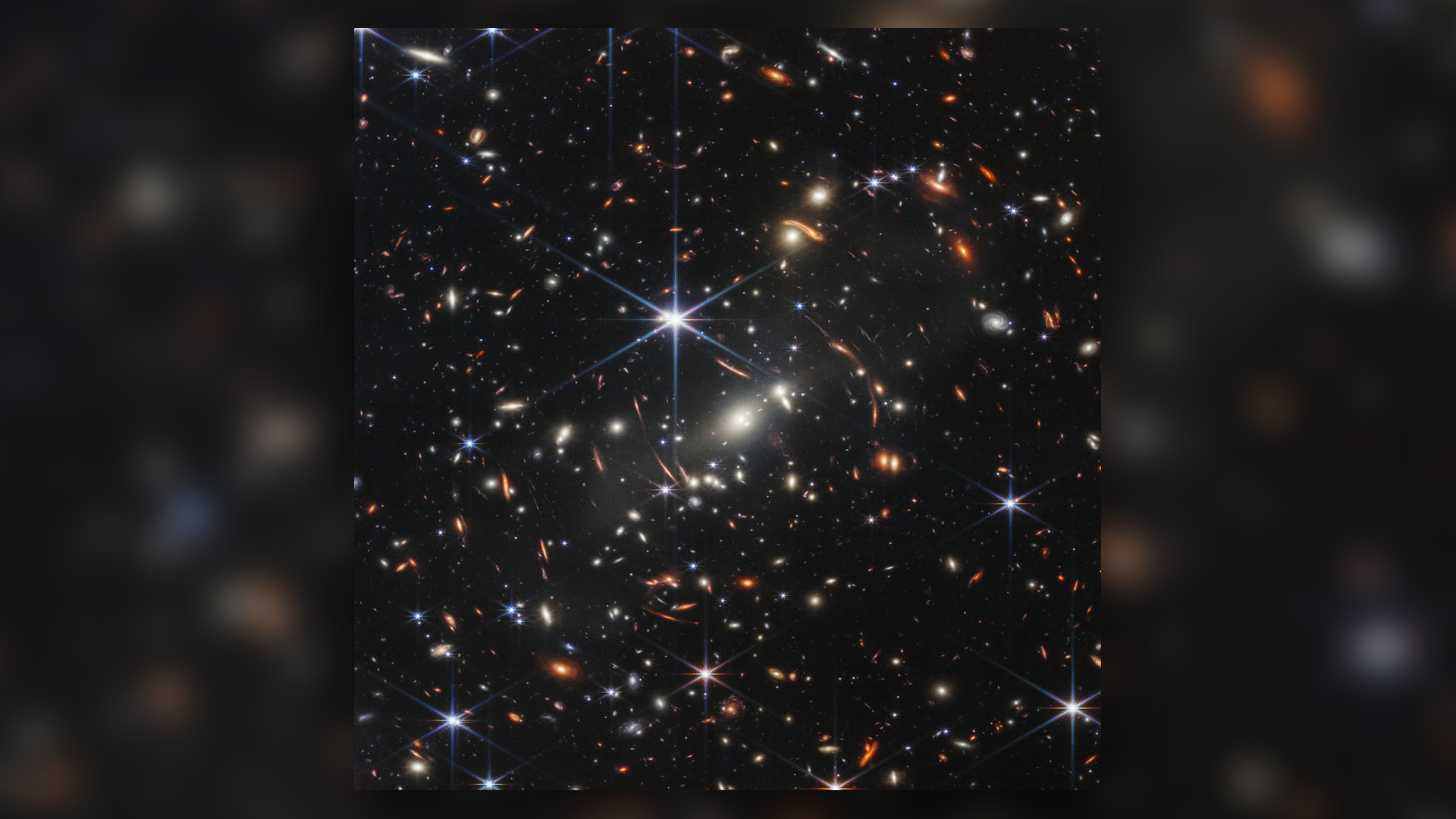
On July 12, NASA revealed four more debut images from the JWST. These included a spectrum image of a nearby alien exoplanet, which reveals the precise chemical composition of the planet's atmosphere, and several dazzling close-ups of enormous, dust-shrouded objects located throughout the universe.
Perhaps the most iconic early image is JWST's closeup of the Carina Nebula, a bright and gassy hotbed of star formation located approximately 7,600 light-years from Earth. Scientists have studied this nebula extensively, but the new image reveals the "cosmic cliffs" of Carina in more stunning detail than ever before. Hundreds of newborn stars, previously invisible to telescopes, shine throughout the gassy landscape of the nebula. Jets and eddies of dust swirl through the image, creating strange structures that scientists can't even identify, according to NASA.
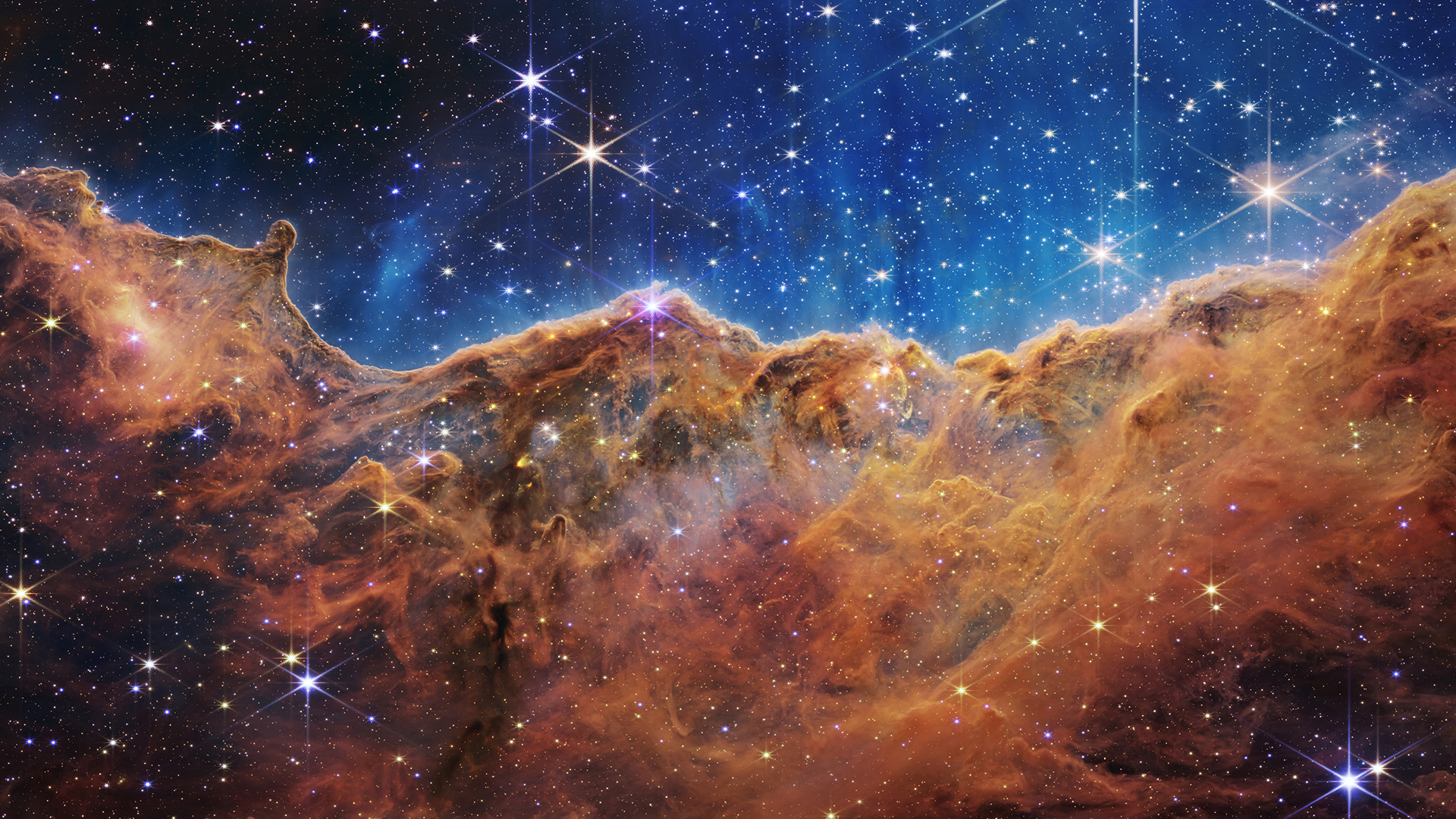
Another popular image shows the Southern Ring Nebula, or "Eight-Burst Nebula" — a figure-eight-shaped cloud of gas and dust expelled by a massive, dying star some 2,500 light-years from Earth. The spectacular image shows a glowing orange foam of molecular hydrogen swirling around a blue haze of ionized gas, bursting out of doomed star at the image's center.
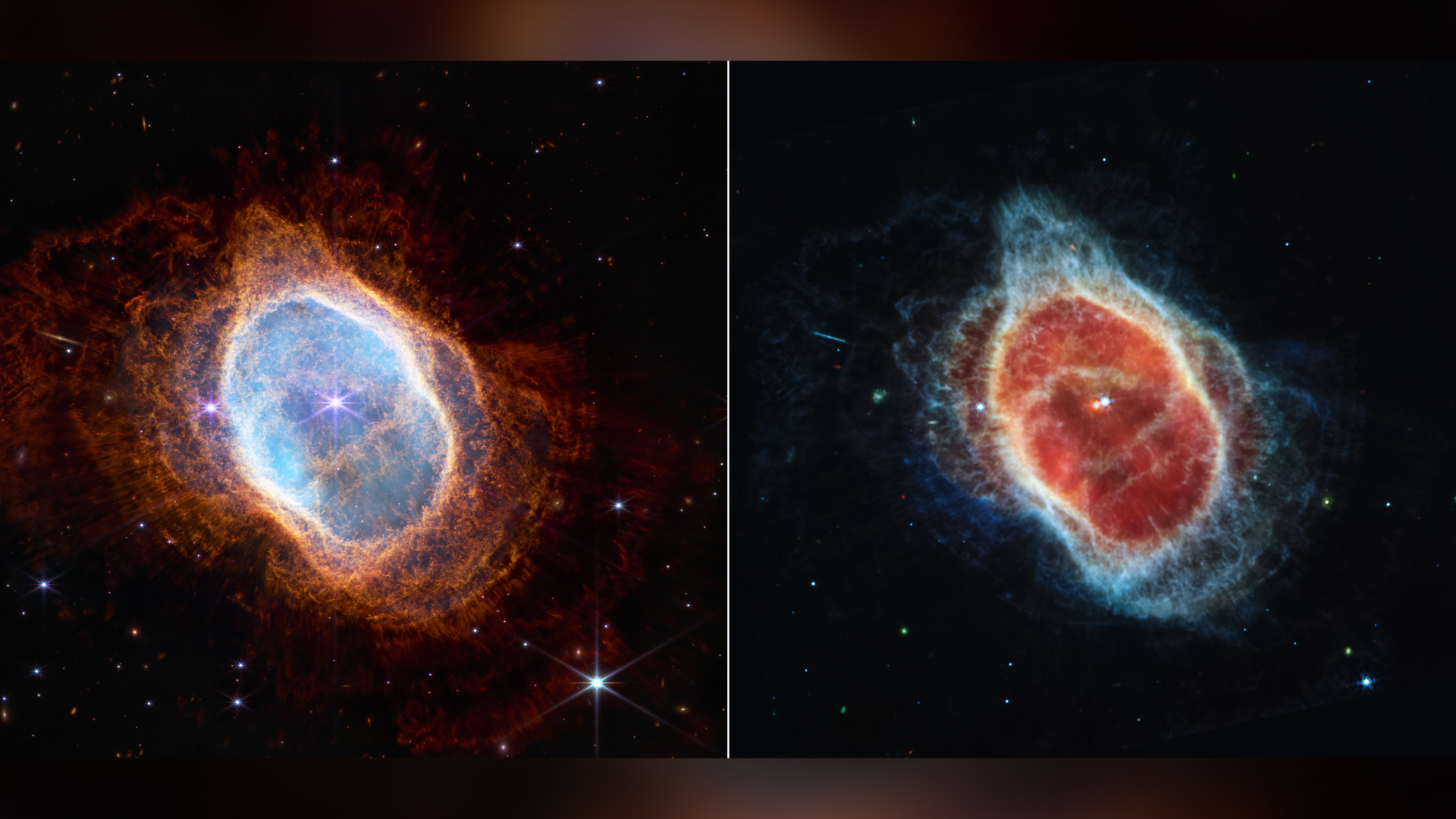
JWST major findings
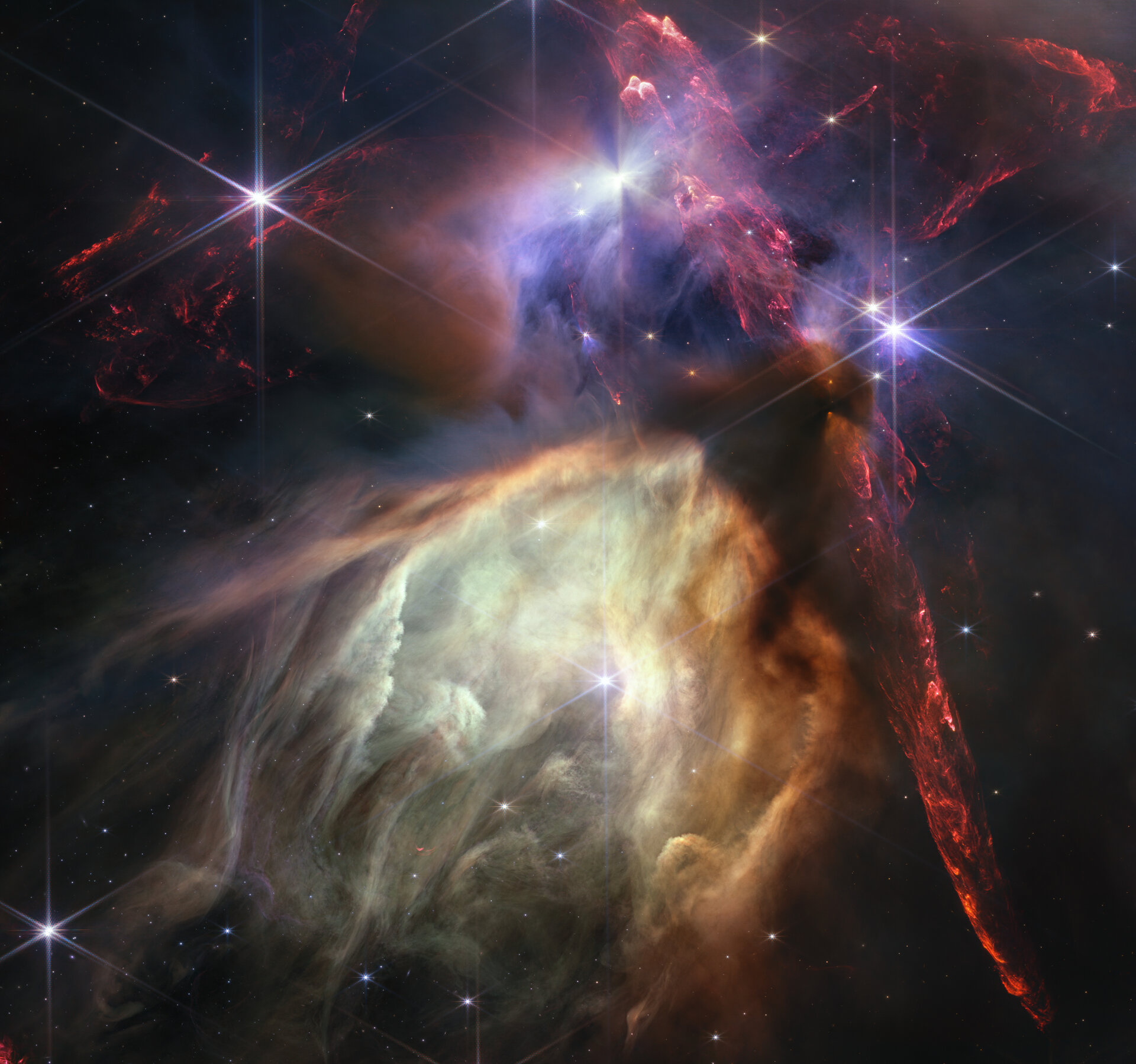
Within its first full year of operations, JWST peered further into the cosmic past than any telescope before it, revealing many groundbreaking discoveries.
One overarching theme of Webb's early observations is that the young universe seems to have grown much more quickly than scientists previously thought. This idea is supported by the discovery of the oldest galaxies in the known universe, dating between 300 and 500 million years after the Big Bang. Stars appear to be forming in these galaxies far faster than previously thought possible, given the galaxies' limited time to grow.
Further discoveries of the oldest actively-feeding supermassive black hole in the known universe, dating to less than 600 million years after the Big Bang, and populations of supermassive stars — some measuring 10,000 times the mass of the sun at just 440 million years after the Big Bang — also suggest that the cosmos grew up quicker than previously estimated. Scientists are still grappling with the implications of these discoveries.
Other notable discoveries include Webb's detection of the oldest complex organic molecules in space, the coldest ice in the universe and the faintest galaxy ever seen — dating to when the universe was about 4% of its current age.
Where does JWST 'live' in space?
A key feature of Webb's design is that it has a "cold side" and a "hot side." The cold side is the one that does the observing, while the hot side carries the spacecraft's solar panels and an antenna for two-way communication with Earth. But this arrangement only works if the sun and Earth are always facing in the same direction from the spacecraft's point of view.
This wouldn't be the case if Webb were simply placed in Earth orbit like Hubble, nor would it be true if the spacecraft orbited the Sun at a slightly different distance from the Earth's orbit. But it turns out there is one special distance at which an object can orbit the Sun and always see the Sun and Earth in the same direction. This is the so-called L2 point — and it's where the Webb telescope operates.
L2 is one of five locations in space called Lagrange points, after Joseph-Louis Lagrange who studied them in the 18th century. At these locations the gravity of two massive bodies (in this case the Sun and Earth) conspire to keep a third, smaller body (such as an asteroid or spacecraft) in a fixed position relative to the first two. The Lagrange points aren't stationary, but they revolve around the Sun at exactly the same rate as the Earth, so the distance from us always stays the same. In the case of L2, it's around 1 million miles (1.5 million kilometers) away: around four times as far away as the moon.
To get the telescope all the way to L2 required a powerful launch vehicle: the ESA's Ariane 5 rocket. In just 26 minutes following lift-off from French Guiana, this carried Webb free of Earth's atmosphere and put it on course for L2. The spacecraft then separated from the rocket and cruised for around a month, making small adjustments to its trajectory before finally arriving at L2 on Jan. 24, Live Science previously reported.
How does the Webb telescope work?
Externally, the JWST looks very different from Hubble. The latter, just like a traditional telescope, is enclosed in a cylindrical tube that shields the optics from stray light. Depending on its position in its orbit, Hubble can be exposed to a lot of light: blazing sunshine from one direction, reflections from the Earth's surface in another, and sometimes even the moon.
But Webb is more fortunate. Seen from the L2 point all these bright sources are in more or less the same direction, so all the telescope needs is a single large sunshield. The bare optics, in the form of primary and secondary mirrors, then sit on top of this. The result, at first glance, looks more like a radio telescope than an optical one.
Functionally, however, both Webb and Hubble are constructed on the same principles. They're both built around a large primary mirror, which has the crucial job of capturing as much light as possible from objects that may be on the very edge of the observable universe. In essence, the bigger this mirror is, the better.
In Hubble's case it's 8 feet (2.4 meters) in diameter, and made from a single circular piece of glass. If this was scaled up to the size needed for the JWST — around 21.3 feet (6.5 meters) across — then not only would it be extremely difficult to fabricate, but the result would be too large and heavy to launch into space, according to NASA.
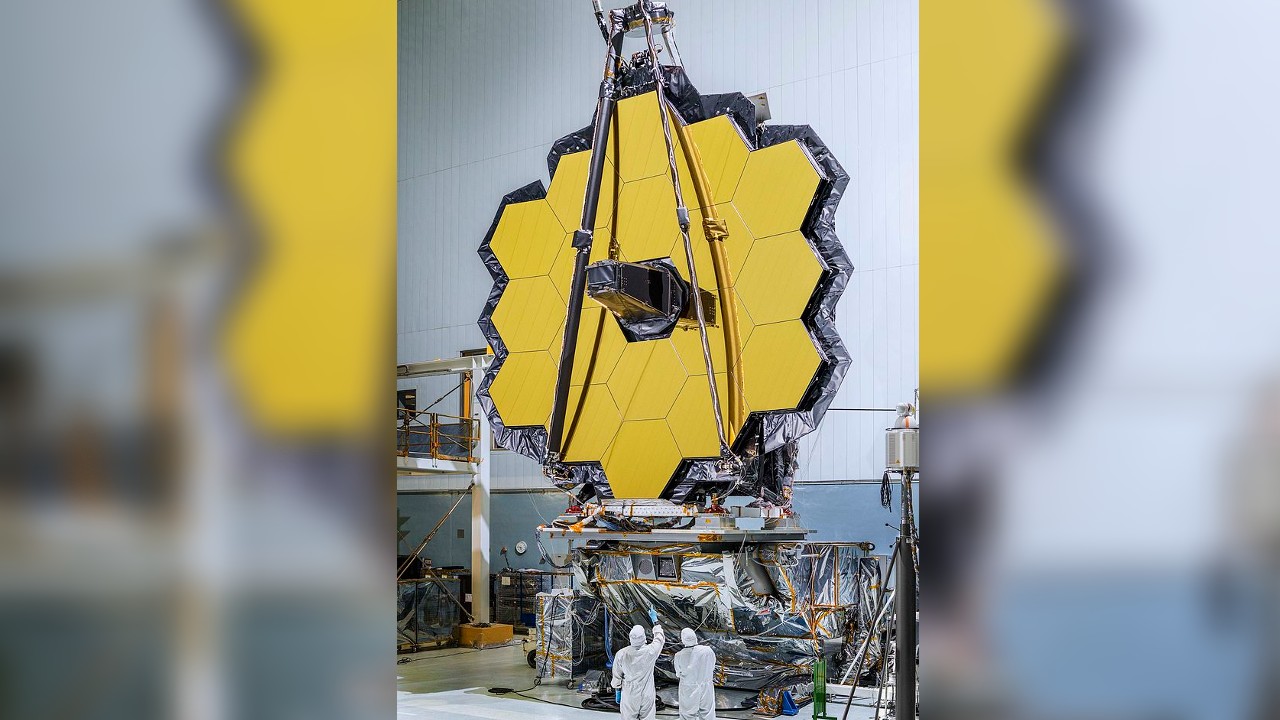
Instead, Webb's mirror is constructed from 18 hexagonal segments, which were folded up for launch and then deployed into an operational configuration once in space. Although NASA considered making the segments from glass, like Hubble's mirror, in the end they used beryllium: a very strong, lightweight metal commonly employed in high-speed aircraft and space vehicles.
This needs to be shaped and polished to extremely high accuracy in order to produce images with the necessary clarity; NASA estimates the polishing error to be less than a millionth of an inch. After achieving the desired shape, the mirror segments were then coated with a thin layer of pure gold, to maximize reflectivity at infrared wavelengths.
When all the segments are put together, they achieve the desired 21.3-foot (6.5-meter) diameter for the main mirror. That's around 2.7 times as big as Hubble's, but the actual performance improvement is much greater than this.
That's because the light-collecting power of a mirror is proportional to its area rather than its diameter. Allowing for the hexagonal shape of the segments and the hole in the center, the effective area of Webb's mirror is 269 square feet (25 square meters), compared with 43 square feet (4 square meters) for Hubble. That equates to a performance improvement of better than a factor of six.
Related: Cosmology: Uncovering the story of the universe
JWST’s sunshield
Located at the L2 point, the JWST sits in constant bright sunshine. This is healthy for the equipment in the spacecraft bus, but bad news for the optical instruments and science module. Because they observe via infrared, these need to be kept as cold as possible in order to function correctly.
So the two halves of the spacecraft will be separated by a huge, kite-shaped, five-layer sunshield roughly the size of a tennis court. While the sunlit side may reach temperatures of 212 degrees Fahrenheit (100 degrees Celsius), the cold side will be as low as minus 394 F (minus 237 C) according to NASA's JWST website.
All five layers of the sunshield were successfully deployed on Jan. 24, Space.com reported.
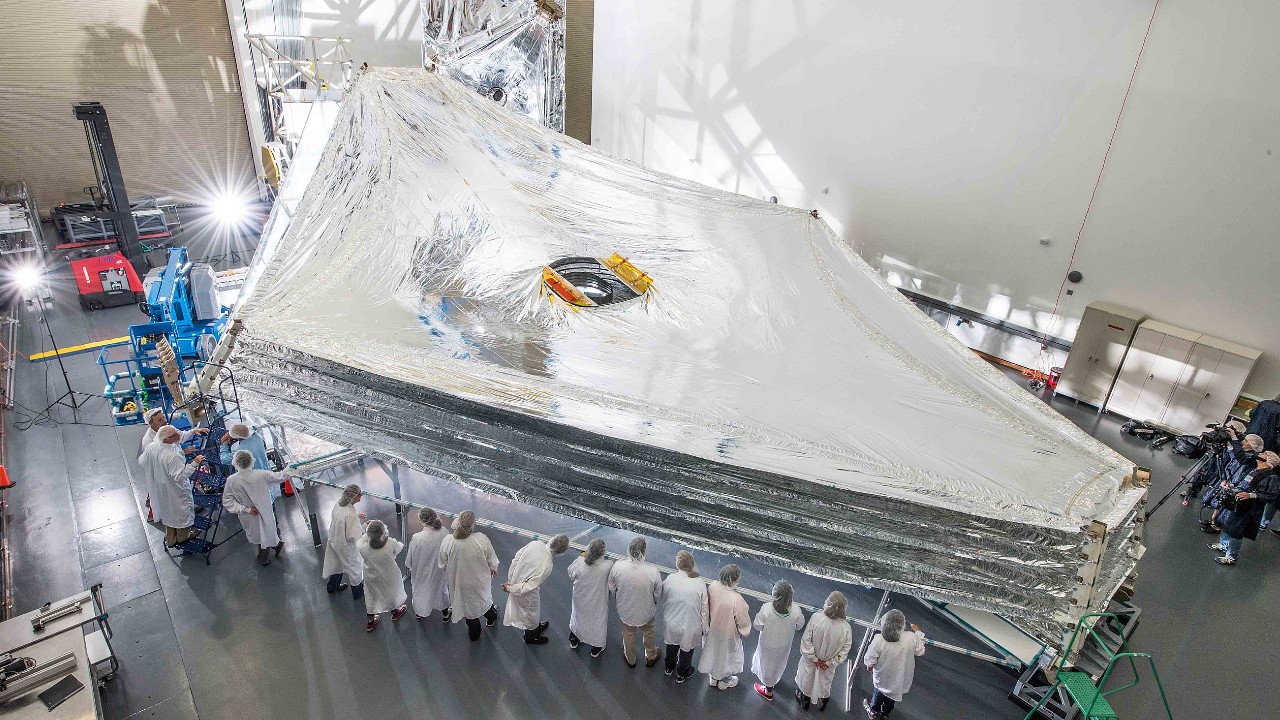
Why do JWT'S optical instruments observe in infrared?
We normally think of astronomy in terms of visible light, because that's what our eyes and traditional telescopes see. But astronomical objects produce emissions across the whole of the electromagnetic spectrum, from very long wavelength radio waves to very short wavelength X-rays and gamma rays. Our eyes evolved to see the wavelengths they do because that's where the sun emits most of its energy, but cooler objects, such as planets and newly formed stars, tend to radiate at longer wavelengths than this, according to research published in 2021 in the journal Eye.
This is one reason why infrared telescopes such as Webb (and its predecessor, NASA's Spitzer space telescope, which operated between 2003 and 2020) are so important. A second reason is that while the dust in galaxies absorbs visible light, it's virtually transparent to infrared waves. This means even sun-like stars can be easier to see in the infrared if there's a lot of intervening dust, according to NASA.
On Feb. 2, NASA engineers began conducting the first imaging tests with Webb, with the 18 mirror segments capturing images of stars that would then be used to align the primary mirror, so that the 18 individual images eventually merge to become a single star, NASA reported.
What are the mission objectives of JWST?
Objective 1: The early universe
Webb is sometimes described as a "time machine," which in a sense it is. Because light from distant objects travels at finite speed, we see them as they used to be in the past. Hubble has shown us galaxies as they were many billions of years ago, but the JWST will be even more sensitive. NASA hopes it will see all the way back to when the first galaxies formed, around 13.6 billion years ago.
And Webb has another advantage over visible-band telescopes like Hubble.
Because the universe is expanding, light from distant objects is stretched out, increasing its wavelength. This means light emitted in the visible waveband actually reaches us in the infrared, the band that the JWST is optimized for. One of its first tasks will be a survey, called COSMOS-Webb, of the most distant galaxies in a specific patch of sky, to explore conditions at the dawn of the universe.
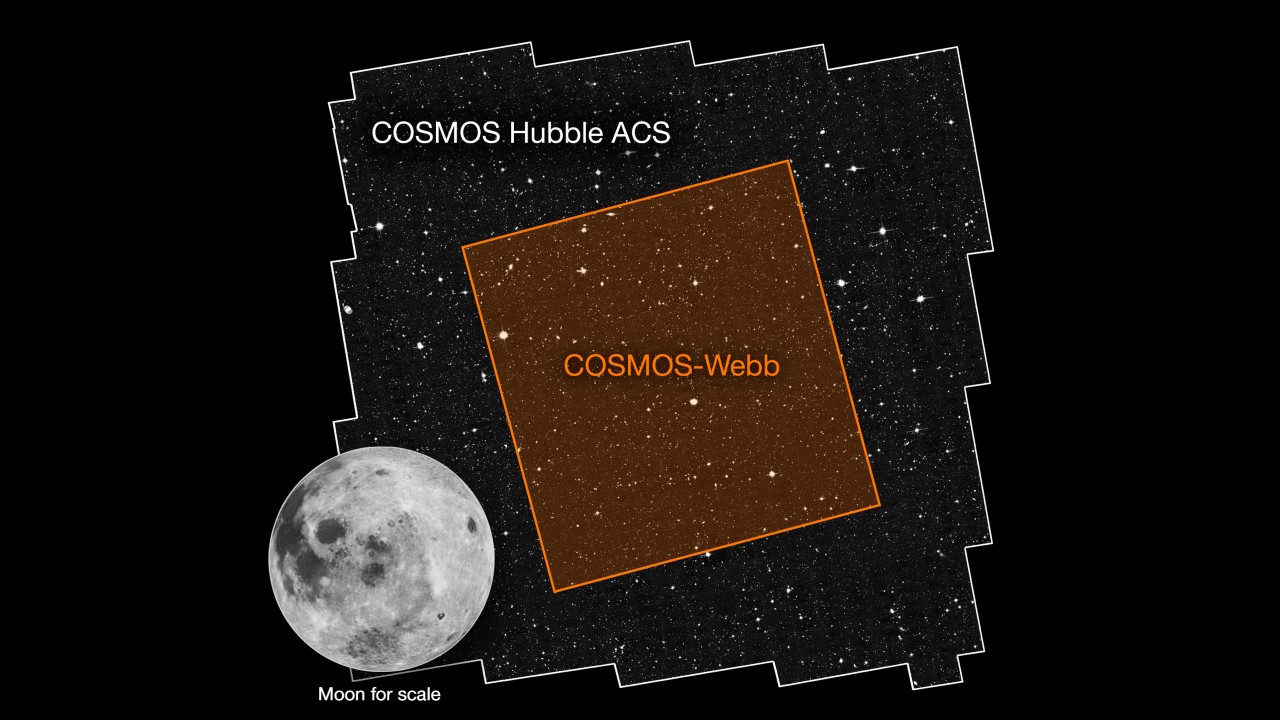
Objective 2: Galaxies over time
Thanks to Hubble's spectacular imagery, most people know what galaxies look like: huge collections of stars, often arranged in elegantly symmetric spiral patterns. But these tend to be relatively nearby galaxies, and hence mature ones. The tantalizing glimpses Hubble has provided of very early galaxies suggests they are considerably smaller and messier-looking.
As yet, no one knows how these proto-galaxies formed, or how they subsequently clumped together to produce the larger, regular-looking galaxies we see today, according to the California Institute of Technology. It's hoped that Webb will be able to answer questions like these with its ultra-deep view of the early universe.
Another well-established feature of galaxies is the presence of supermassive black holes in the centers of most of them. In the early universe, these black holes often powered enormously bright galactic nuclei called quasars, and Webb is scheduled to study six of the most distant and luminous examples of these.
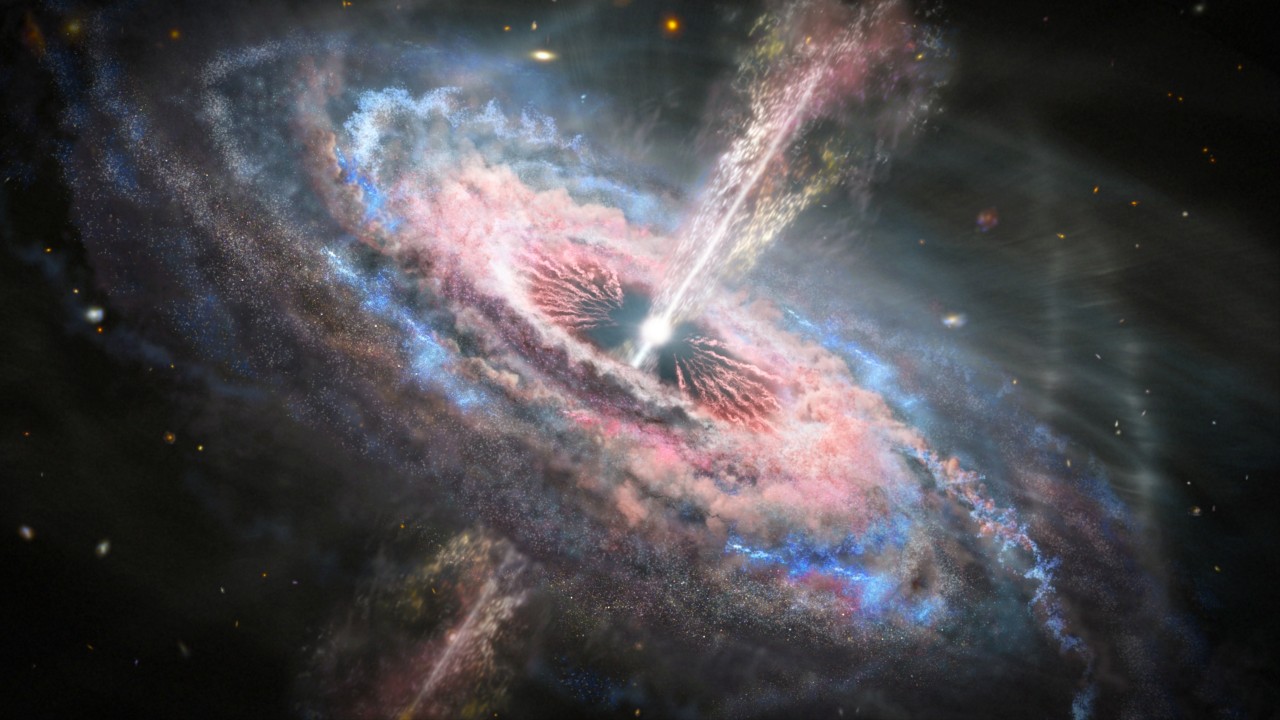
Objective 3: Lifecycle of stars
The galaxies that fill the universe originated very early on, and they've steadily evolved ever since then. But that's not true of the stars inside them, which go through life cycles more akin to living creatures. They're born, develop, age and die, and the remnants of old stars contribute to the raw material needed to make new stars. Much of this process is well understood, but there's still a mystery surrounding the actual birth of stars, and the planetary discs that may form around them.
That's because baby stars are initially enveloped inside a cocoon of dust, which ordinary telescopes using visible light can't penetrate. But all this dust will be virtually transparent at the infrared wavelengths used by Webb, so NASA hopes it will finally reveal the ultimate secrets of star formation. In turn, this may teach us something about the origins of our own sun and solar system.
Objective 4: Other worlds
One of the most exciting areas of contemporary astronomy is the search for exoplanets orbiting other stars, particularly Earth-like planets that may have the chemical ingredients and conditions necessary for life to evolve. The JWST will contribute to this search in several ways, using infrared imaging and spectroscopy to study the chemical and physical properties of planetary systems.
Its ability to peer through dust and snap super-high resolution images should provide us with a direct view of planetary systems — such as that of the newly formed star Beta Pictoris — in their very earliest stages, according to NASA's JWST website. Webb will also analyze the chemical composition of exoplanet atmospheres, looking in particular for tell-tale signatures of the building blocks of life. This again is something an infrared telescope is ideally suited for, because the molecules making up planetary atmospheres tend to be most active at these wavelengths.
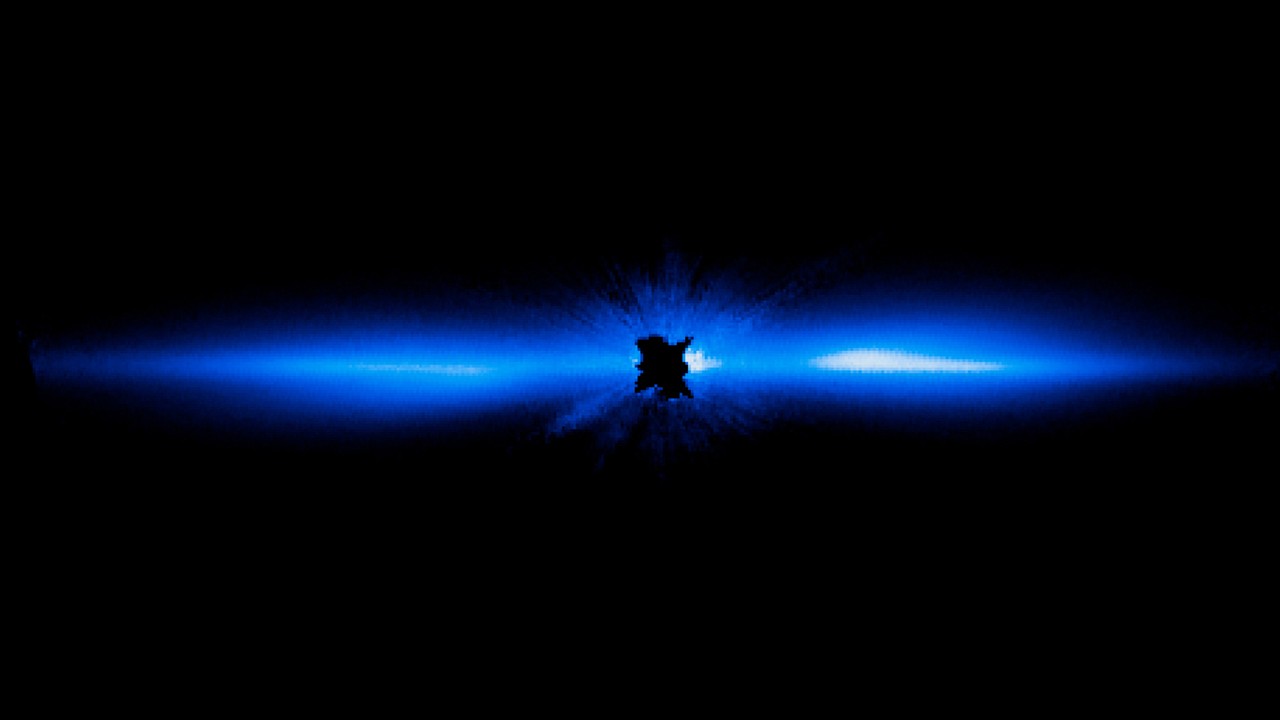
Q&A with an Astrophysicist
We asked NASA's Dr Mike McElwain about his hopes for the new telescope.
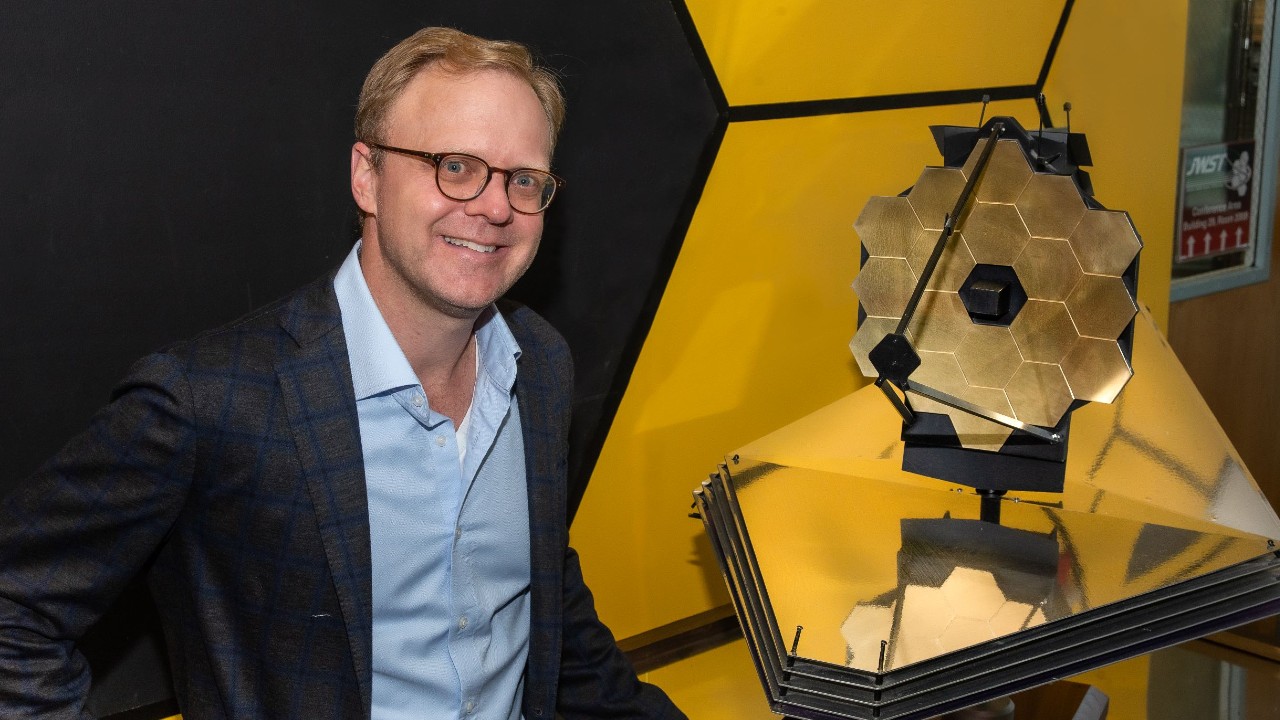
What sort of science will the telescope do in its first year?
In the first year, Webb's observing program will run the cosmic gamut: from the first light in the early universe to exoplanet atmospheres. Webb will observe the most interesting objects in the universe with a combination of improved resolution, sensitivity and wavelength coverage. This will enable new and enhanced characterization of the famous objects in the sky. If you can name it, Webb is likely to observe it, though maybe not all in the first year.
What are the most exciting discoveries the JWST might make?
When you have an observatory as transformational as Webb, the most exciting discoveries are likely to be the ones that we don’t even anticipate! Webb’s infrared eyes on the universe will enable us to see space where we were previously blind. Its unprecedented infrared sensitivity will help astronomers compare the earliest galaxies to today's grand spirals and ellipticals, helping us to understand how galaxies assemble over billions of years. It will be able to see right through and into massive clouds of dust that are opaque to visible-light observatories like Hubble, where stars and planetary systems are being born. Webb will tell us more about the atmospheres of extrasolar planets, and perhaps even find the building blocks of life elsewhere in the universe.
Do you think Webb will become a household name like Hubble?
I fully expect it will, and that people around the globe will be discussing Webb imagery while sitting around the dinner table. Similar to Hubble, Webb will produce spectacular images of the cosmos that will captivate the imagination. We expect Webb imagery to go viral on the internet, show up in calendars and occupy space on household coffee tables.
Editor's Note: This article was updated to reflect new JWST discoveries on July 13, 2023.
Additional resources
- Want a crash-course on the Webb Telescope? Check out James Webb Space Telescope: A Super-Quick Guide on Kindle, for a fast introduction to the pioneering observatory.
- If you'd prefer a deeper dive, you can learn about the Webb mission from the European Space Agency (ESA).
- For spectacular images of Webb — and its partner in space, Hubble — visit this ESA gallery.
Sign up for the Live Science daily newsletter now
Get the world’s most fascinating discoveries delivered straight to your inbox.
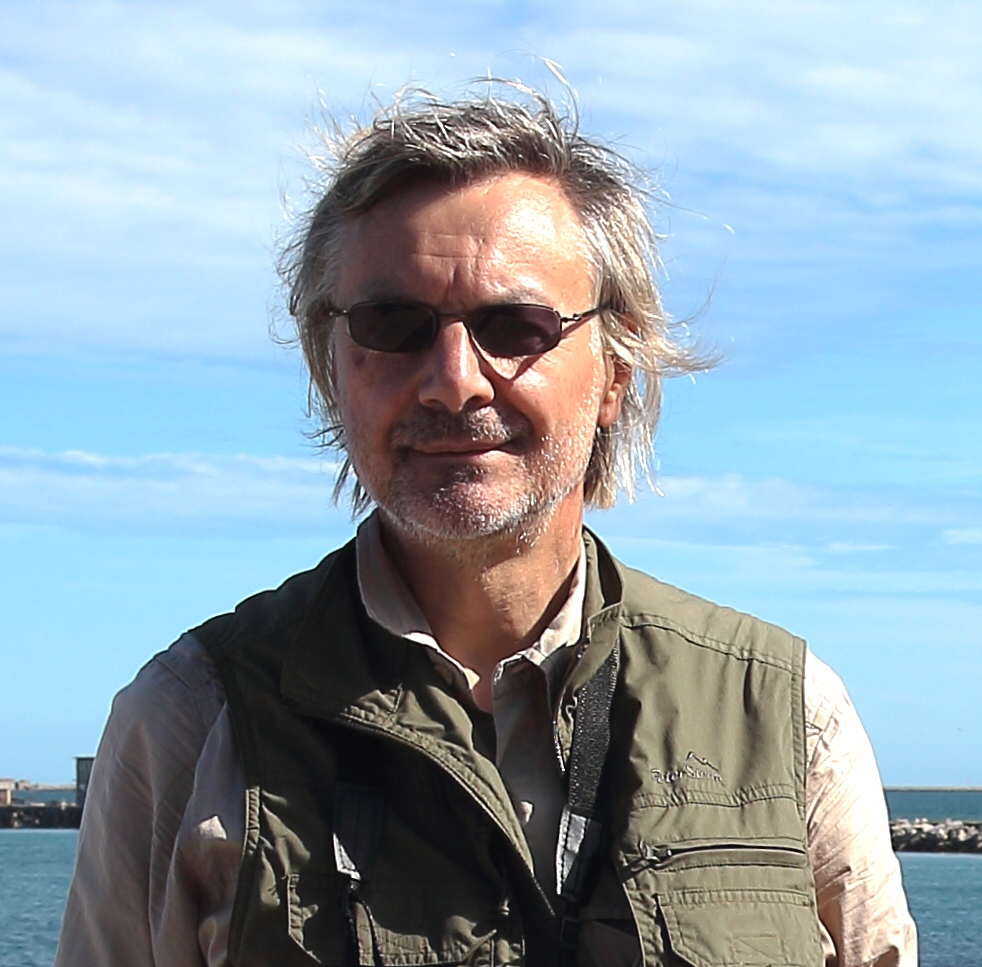
Andrew May holds a Ph.D. in astrophysics from Manchester University, U.K. For 30 years, he worked in the academic, government and private sectors, before becoming a science writer where he has written for Fortean Times, How It Works, All About Space, BBC Science Focus, among others. He has also written a selection of books including Cosmic Impact and Astrobiology: The Search for Life Elsewhere in the Universe, published by Icon Books.
- Brandon SpecktorEditor
- Mindy WeisbergerLive Science Contributor










